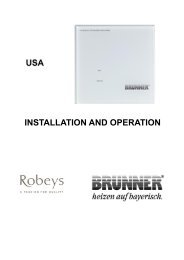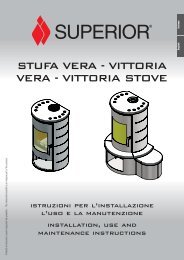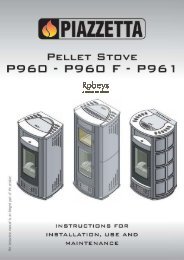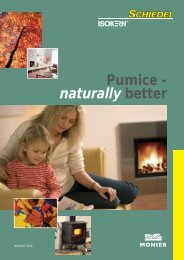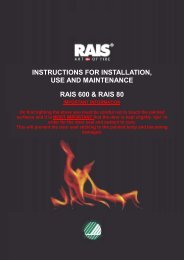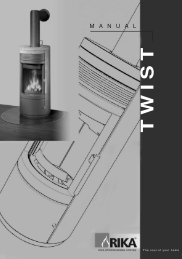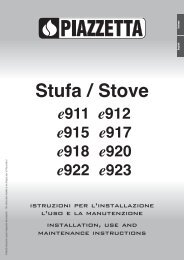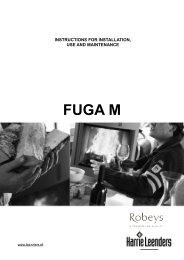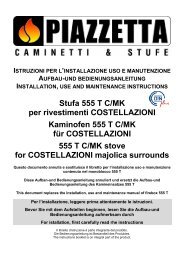instructions for installation, use and maintenance rais ... - Robeys Ltd
instructions for installation, use and maintenance rais ... - Robeys Ltd
instructions for installation, use and maintenance rais ... - Robeys Ltd
You also want an ePaper? Increase the reach of your titles
YUMPU automatically turns print PDFs into web optimized ePapers that Google loves.
Drying <strong>and</strong> storageDrying wood takes time: proper air drying takes approximately 2 years.Here are some tips:Store the wood sawn, split <strong>and</strong> stacked in an airy, sunny place, which is protected againstrain (the south side of the ho<strong>use</strong> is particularly suitable).Store the firewood stacks at a h<strong>and</strong>'s breadth apart, as this ensures that the air flowingthrough takes the moisture with it. Avoid covering the firewood stacks with plastic, as thisprevents the moisture from escaping. It is a good idea to bring the firewood into the ho<strong>use</strong>23 days be<strong>for</strong>e you need it.Regulating the combustion airAll RAIS stoves are equipped with a oneh<strong>and</strong>ed operating lever <strong>for</strong> regulating the damper.The stovespecific regulating mechanisms can be seen on the diagrams.Primary air is the combustion air added to the primary combustion zone, i.e. the bed ofglowing embers. This air, which is cold, is only <strong>use</strong>d in the lighting stage. Secondary air isthe air which is added in the gas combustion zone, i.e. air which contributes to thecombustion of the pyrolysis gasses (preheated air, which is <strong>use</strong>d <strong>for</strong> the cleaner glasssystem <strong>and</strong> combustion). This air is sucked through the damper under the combustionchamber <strong>and</strong> is preheated through the side channels <strong>and</strong> then emitted as hot scavengingair onto the glass. The hot air rinses the glass <strong>and</strong> keeps it sootfree.The tertiary channel, which can be seen at the top of the combustion chamber towards theback, serves to combust the final gas residues.By setting the interval between position 1 <strong>and</strong> 2, the energy content in the firewood is <strong>use</strong>doptimally, as there is oxygen <strong>for</strong> combustion <strong>and</strong> <strong>for</strong> the burning of the pyrolysis gasses.When the flames are a clear yellow the damper has been set correctly. Finding the correctposition comes with time after you have <strong>use</strong>d <strong>for</strong> stove <strong>for</strong> a while.It is not recommended that you turn it down completely. A mistake commonly made isshutting the damper too early beca<strong>use</strong> it feels too hot. This results in dark smoke emanatingfrom the chimney <strong>and</strong> in the calorific value of the firewood not being <strong>use</strong>d to its fullest.Room ventilation <strong>and</strong> stovesThere must not be an extractor fan fitted in the same room as the stove as this can ca<strong>use</strong>the stove to emit smoke <strong>and</strong> fumes into the room.The stove requires a permanent <strong>and</strong> adequate air supply in order <strong>for</strong> it to operate safely <strong>and</strong>efficiently.In accordance with current Building Regulations the installer may have fitted a permanent airsupply vent into the room in which the stove is installed to provide combustion air. This airvent should not under any circumstances be shut off or sealed.





